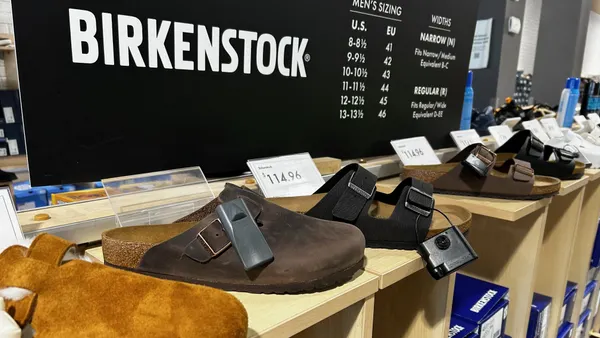Dive Brief:
-
Walmart on Thursday reported that third quarter total revenue rose 4.2% or $5 billion to $123.2 billion; adjusting for currency fluctuations, total revenue rose 3.8% or $4.5 billion to $122.7 billion.
-
Net sales online in the quarter rose 50% and gross merchandise volume rose 54%, the company said. U.S. same-store sales rose 2.7%, and same-store traffic increased 1.5%, according to a company press release. Third quarter net sales at Walmart International rose 4.1% to $29.5 billion, or, excluding currency, rose 2.5% to $29.1 billion, an increase of 2.5%.
-
Gross profit margin in the quarter declined 29 basis points, due mostly to price cuts in certain markets and "the mix effects of our growing e-commerce business," although the impact from hurricanes in the U.S. was also a significant contributor, according to a statement from Brett Biggs.
Dive Insight:
Walmart's third quarter marked a year since its $3.3 billion acquisition of Jet.com, which continues to fuel its formidable e-commerce growth. But the world’s most efficient brick-and-mortar retail stalwart is departing from its strategy of lean operations to move the needle on online sales.
"Walmart’s online performance continues to validate its substantial investments in this critical channel, including its purchase of Jet.com, with 50% year-over-year growth well-ahead of the company’s stated 40% target," Moody’s Lead Retail Analyst Charlie O’Shea said in an email to Retail Dive. "U.S. revenues increased a meaningful $3.2 billion, though came at a cost as Walmart’s aggressive pricing strategy amid its battle for market share with lower-margin Amazon, coupled with its ongoing investments, depressed both gross and operating margins."
The price competition will likely continue into the holidays, O’Shea also said, noting that "this season is shaping up as potentially more promotional than even last year."
Walmart’s emphasis on in-store pickup of online sales was particularly helpful in growing grocery sales, Moody’s noted. "Market share in the critical food category continues to grow as the expansion of its buy-online/pick-up in store capability is driving increased sales, and the focus on improving working capital continues, with payables increasing significantly on flattish inventory levels," O’Shea said. "As usual, we expect Walmart to largely set the tone on multiple fronts and in multiple categories for the holiday season."
Amazon continues to cast a shadow over Walmart when it comes to e-commerce and drives Walmart’s redoubled e-commerce efforts, including deepening apparel merchandising through further acquisitions like Modcloth and Bonobos and the recently announced partnership with Lord & Taylor. Additionally, brick-and-mortar stores are adding plenty of fuel to Walmart's fire, suggested GlobalData Retail Managing Director Neil Saunders. "Traffic held up well across the U.S. estate, with price cuts helping to keep customers loyal, especially in categories like grocery," he said in an email to Retail Dive. "Some modest improvements to store layout and design have also aided conversion rates, particularly in non-food categories. For a retailer of its size and scale, we believe that Walmart's ability to keep its stores growing is impressive."
When it comes to e-commerce, Walmart doesn’t have to beat Amazon to win, according to Investing.com Senior Market Analyst Clement Thibault. "It won't become Amazon — but it doesn't have to," he said in an email to Retail Dive. "It has to make sure it remains a viable alternative to Amazon. The e-commerce space will continue to grow, and while it is a zero-sum game, the pie is big enough to sustain multiple players."
But in being so reactive to Amazon, Walmart may be making the long-term mistake that the dozens of discount retailers made decades ago, when Walmart itself first emerged on the landscape, with the fierce dedication to always low prices and super-efficient operations envisioned by founder Sam Walton, according to Howard Davidowitz, chairman of New York City-based retail consulting and investment banking firm Davidowitz & Associates.
"Sam Walton was always four steps ahead," Davidowitz told Retail Dive in an interview. "All the other guys copied Walmart and they don’t exist. Now that’s what Walmart’s doing" — copying Amazon.
Despite their efforts to mimic Walmart, Woolworth’s, Topp’s and other banners were "mowed down by Walmart along with all the other discounters in America," Davidowitz warned. "Target is the only discounter that survived because they found a way to differentiate themselves from Walmart," he said. "Target found a niche and distinguished themselves by going the other way and did a great job for many years. If you’re going to fight Bezos — you’re never going to catch Bezos — so you have to do something different."














